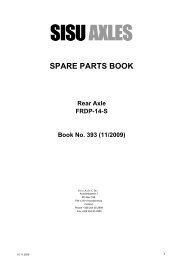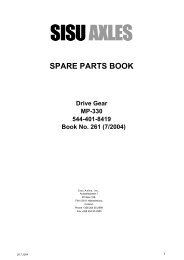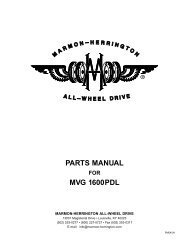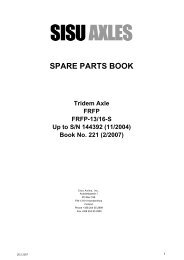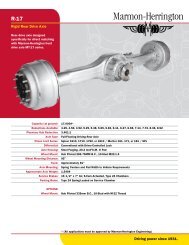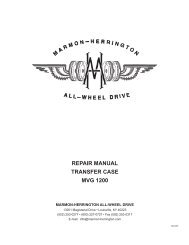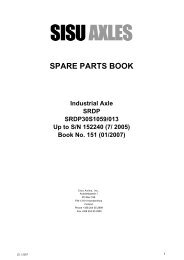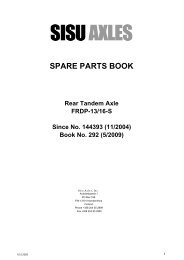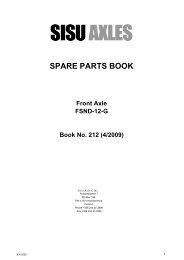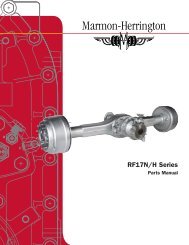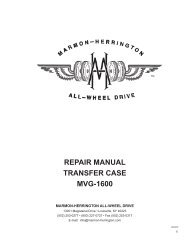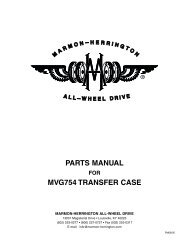workshop manual rear axles rf17n/h r17n/h - Marmon-Herrington
workshop manual rear axles rf17n/h r17n/h - Marmon-Herrington
workshop manual rear axles rf17n/h r17n/h - Marmon-Herrington
You also want an ePaper? Increase the reach of your titles
YUMPU automatically turns print PDFs into web optimized ePapers that Google loves.
This <strong>manual</strong> has been prepared for owners and operators<br />
of vehicles equipped with <strong>Marmon</strong>-<strong>Herrington</strong><br />
All-Wheel-Drive systems and components. For additional<br />
technical assistance, contact <strong>Marmon</strong>-<strong>Herrington</strong><br />
Customer Service.<br />
Please observe and follow all procedural and maintenance<br />
guidelines to ensure reliable operation and<br />
optimum service life. The <strong>Marmon</strong>-<strong>Herrington</strong> basic<br />
service schedule will integrate seamlessly with most<br />
preventative maintenance programs.<br />
<strong>Marmon</strong>-<strong>Herrington</strong> shall not be liable for component<br />
failures or damages caused by operational abuse or<br />
neglect. Please review the Warranty Statement for a<br />
detailed explanation of coverage and claim reporting<br />
procedures.<br />
We thank you for your investment in <strong>Marmon</strong>-<strong>Herrington</strong><br />
equipment, and look forward to serving your<br />
needs in the tradition of engineering excellence.<br />
GENERAL OPERATION STATEMENT<br />
As close as engineers try to match gear ratios and<br />
tires for a given application, the reality is that there will<br />
always be some degree of ratio mis-match between<br />
front and <strong>rear</strong> <strong>axles</strong>. When a vehicle is operated on a<br />
hard, dry surface with the front axle engaged (AWD,<br />
4X4, 6X6 modes), the tires are not able to slip and<br />
relieve the torsional forces being generated.<br />
As such, <strong>Marmon</strong>-<strong>Herrington</strong> equipped vehicles are<br />
designed for “as needed” AWD operation only, in<br />
“off-raod” or poor traction conditions. They are not<br />
intended to be driven in AWD mode on hard, dry surfaces.<br />
Note: Seek expert advice when considering tire size<br />
or gear ratios changes.<br />
SHIFTING OF AXLE OR TRANSFER CASE<br />
<strong>Marmon</strong>-<strong>Herrington</strong> Axles and Transfer Cases use<br />
no clutching or synchronization devices, and there-<br />
SECTION 203.<br />
FOREWORD<br />
fore should only be shifted when the vehicle is at a<br />
complete stop. This applies to front axle engagement,<br />
high and low ranges, and locking differentials.<br />
The only exceptions are those vehicles equipped with<br />
<strong>Marmon</strong>-<strong>Herrington</strong>’s Safety-Shift system, which are<br />
calibrated to shift up to 5 mph.<br />
“Shifting on the fly” generally results in two types of<br />
damage. The first is degradation of the engagement<br />
teeth due to relative rotation of the drive gears and<br />
shift collars. This type of damage can prevent the<br />
case from shifting normally, as the teeth become<br />
burred and cannot mesh.<br />
The second condition occurs when a shift is actually<br />
completed at excessive speed. This results in extreme<br />
torque loading that is transmitted through the<br />
transfer case, drive shafts, and <strong>axles</strong>. The extent of<br />
possible damage increases proportionately with the<br />
vehicle speed.<br />
SUMMARY<br />
Before retreating from the subject of shifting, it must<br />
be reemphasized that no transfer case, PTO, axle<br />
differential, or power divider should ever be shifted<br />
while the vehicle is in motion. The engagement<br />
of these components is intended for off-road only,<br />
in poor traction conditions.<br />
TORQUE<br />
“Torque Shock” or “Torque Loading” is a damaging<br />
mode of failure that is easily avoidable. It generally<br />
occurs in situations wherein a vehicle is operating in<br />
an area of low traction at high RPM with the wheels<br />
spinning. When the tires make abrupt contact with a<br />
tractable surface, a violent shock-load is transmitted<br />
through the drive train. This can result in damages<br />
to <strong>axles</strong>, drive shafts, transfer cases and transmissions.<br />
Simply engaging the front axle and operating in low<br />
range at lower speeds will allow the vehicle to proceed<br />
without imparting undue stress to the drive train.<br />
9



